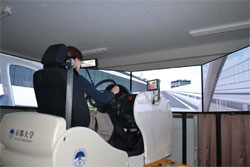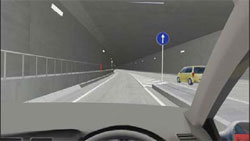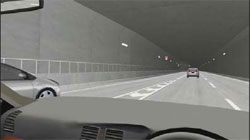About 7km west of Kyoto Station as the crow flies, Kyoto University Katsura Campus is located on the quiet hill. It was opened in 2003 as the third campus of Kyoto Univ., following Yoshida Campus where the central function of the university is placed since its foundation (in Sakyo-ku) and Uji Campus that accommodate main sections for natural science and energy studies (in Uji city). The campus has been designated to form a new base for research and education "Techno-science hill" that merges technology and science.
 |
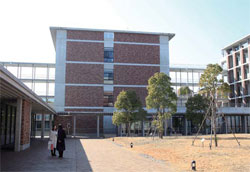 |
| School gate of Katsura Campus of Kyoto University (Left) / C cluster - C1 building in which DS for advanced research is set up (Right) |
|
This issue picks up the user from Katsura Campus: Department of Urban Management, Graduate School of Engineering, Kyoto University. We focus in particular on Logistics Management Systems Laboratory led by Professor Eiichi Taniguchi and Intelligent Transport Systems Laboratory led by Associate Professor Nobuhiro Uno.
Professor Eiichi Taniguchi and others were originally measuring the drivers' behavior and their brain activities using real cars on public roads in conformity with the code of ethics provided by Kyoto University. On the other hand, Associate Professor Nobuhiro Uno and others were mainly observing behavior of various vehicles from the outside using some approaches such as image analysis for managing heavy traffic that circulates in cities safely and smoothly. However, they felt a limit of collecting data required for studies only with the approaches each of them had been using individually. Noticing the necessity of utilizing the driving simulator (DS) from early on, these two laboratories and others encouraged the univ. to adopt one. With their proposal accepted last spring, they adopted FORUM8's DS for high-level studies with 6-DOF (Degrees of Freedom) motion platform.
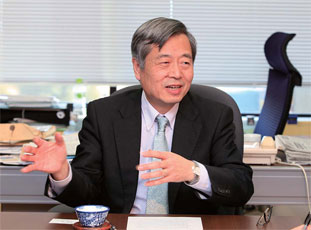 |
 |
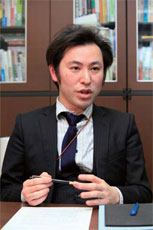 |
| Prof. Eichi Taniguchi, Logistics Management Systems Laboratory Department of Urban Management, Graduate School of Engineering, Kyoto University |
Prof. Nobuhiro Uno Intelligent Transport Systems Laboratory Department of Urban Management, Graduate School of Engineering, Kyoto University |
Assistant Prof. Toshiyuki Nakamura Intelligent Transport Systems Laboratory Department of Urban Management, Graduate School of Engineering, Kyoto University |
| Changes in Department of Urban Management and Its System |
The Dept. of Urban Management can trace its history back to the University's founding. It was formed through restructuring of the civil engineering departments (Civil Engineering and Civil System Engineering) and the Department of Environmental Engineering, both of which originate from the Department of Civil Engineering in the College of Science and Engineering within Kyoto Imperial University founded in 1897. After a series of reorganization and expansion of the university organization, the aforementioned civil engineering departments and the Department of Environmental Engineering, which would develop into the Department of Urban Management, were formed in 1996, when restructure was carried out to place more emphasis on the graduate schools. Later in 2003, in order to address new challenges effectively and quickly backed by development of science and technology and information communications technology, 5 global engineering departments (Civil Engineering, Civil System Engineering, Resources Engineering, Environmental Engineering, and Environmental Global Engineering) were reorganized into three Departments of Civil and Earth Resources Engineering, Urban Management, and Environmental Engineering.
Opened in the autumn of 2003, Katsura Campus comprises four clusters from A to D. So far two departments from Electrical and Electronic Divisions and six departments from Chemical Engineering Divisions of the Graduate School of Engineering moved into A cluster. Then three departments of the Global Engineering Division including Department of Urban Management, the Department of Architecture and four departments from Engineering Science Divisions moved to C cluster. Research and educational functions of the Graduate School of Engineering has accumulated steadily.
The Department of Urban Management aims at creating sustainable, safe, and internationally competitive urban systems that can serve as a base for creative human activities. As such, the Department established specific items to address as follows:
- Renovation of urban ICT and advancing urban infrastructure
- Disaster risk management in advanced information societies
- Development of management technology of urban infrastructure
- Providing Infrastructure to support the global age
- Establishing urban structure based on the limited energy.
To realize these, the Department offers the following lectures.
- Structures Management Engineering,
- Earthquake and Lifeline Engineering,
- River System Engineering and Management,
- Geo-Management,
- Urban Systems Planning,
- Logistics Management Systems,
- Transportation Engineering and Management,
- Environmental Geosphere Engineering,
- Urban Regional Disaster Control,
- Environmental Infrastructure Engineering.
| Logistics Management Systems Laboratory Studying Urban Logistics Systems
with Unit for Liveable Cities |
In considering cities required in the 21st century, Logistics Management Systems Laboratory in Dept. of Urban Management recognizes urban infrastructures including roads, railways and ports as urban systems. Based on this standpoint, the lab explores methods for building and managing efficient and environmentally friendly urban logistics systems. Their specific outcome includes studies on ITS (Inteligent Transport Systems) based stochastic vehicle routing and scheduling problems, minimizing negative effects of e-commerce on urban transport, evaluation methods for performance of policy measures for city logistics, development of new technologies for construction and management of urban infrastructures.
Besides his activities at the lab, Prof. Eiichi Taniguchi also takes part in the educational program "Unit for Liveable Cities", which the Graduate Schools of Engineering and Medicine have been working on since 2010 as the unit director. This unit is concerned with creation of a new field of academic endeavor integrating health, medicine, and urban engineering. It aims to develop human resources ("urban wellbeing creators") capable of proposing and performing integrated and appropriate policies for various problems in modern cities.
Prof. Taniguchi also mentioned a study for optimization of commodity distribution including the movement of trucks in cities, or optimization of the local system that unifies medical care, caregiving and nursing care, stressing the importance of using ITC.
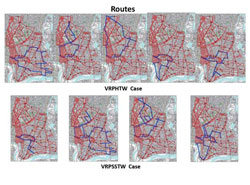 |
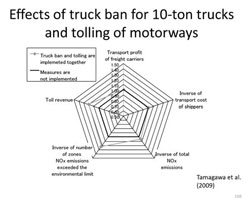 |
| Result of optimized calculation of plan for allocation of vehicles (Left), Result of multi agent simulation (Right) (Photo by Prof. Eichi Taniguchi) |
|
| Intelligent Transport Systems Laboratory ICT is Essential for Smarter Use of Transport System |
On the other hand, Intelligent Transport Systems Laboratory (Division of Transportation Engineering and Management) aims to study various approaches for managing transport systems in general so that they can be used in smarter ways using the concept of ITS. This is the reason that Prof. Yasunori Iida, professor emeritus of Kyoto University named the lab the unique name in Japan, said Associate Professor Nobuhiro Uno. In order to create the safe, secure and comfortable transport system, the lab has been addressing analysis of traffic behavior, assessment of the impact of infrastructure construction or transport policies, and planning of new measures. Its main research topics include the transport network capable of securing reliability during disaster, evaluation methods of road networks in terms of the stability of required time, and influences of vehicle information as well as pricing on human behavior.
Among such activities of the lab, Assistant Professor Toshiyuki Nakamura pays attention to analysis of big data. In recent years in particular, they put emphasis on grasping human traffic behavior using IC card data, modeling tsunami (tidal wave) evacuation behavior and examining acceptability of using automobiles in such evacuation.
Use of ICT has been positioned as the basis of activities since establishment of the lab. In order to increase the effect of traffic congestion measures or safety measures in the future, it is essential to collect and detect information on human behavior and thoughts. In this sense, while the quantity of data to be obtained has significantly increased, it has become a question how to grasp its quality.
| Limits of Experiments in a Real Car and Needs for DS |
"Performing experiments on a public road has limits, leaving a lot of things unclear. Simulation has also its limits as a matter of course, but in order to perform fundamental experiments such simulation was required by all means that can artificially control diverse elements."
In addition, it is not allowed to conduct experiments on any phenomenon that may risk traffic safety or on evaluation of a new policy. Above all, when performing experiments of various patterns over the subjects with varying attributes including elderly people in controllable environment, there is no choice but to depend on DS.
On the other hand, the above-mentioned "Unit for Liveable Cities" measured brain activities according to driving behavior with near-infrared spectroscopy (NIRS) as a part of objective evaluation of the city. However, in experiments using a real car on a public road, traffic conditions and road structure vary from case to case. It is therefore unclear what kind of influences these elements have. In order to separate such elements and make analysis as exactly as possible, DS was required by all means. That's why they had been requesting the university to adopt DS, as Prof. Eiichi Taniguchi stated.
In contrast, Associate Professor Nobuhiro
Uno and others have been focusing on urban expressways for many years as one of
the approaches to manage urban transport safely and smoothly. Keeping
performance index or creation of models in future in mind, they had been
observing behavior of various vehicles around merging sections by image
analysis,
However, since observation from the outside only has a limit in itself,
they recognized necessity of DS to obtain data about human behavior including
individuals' judgment and actions. They also drew up a plan for utilizing
DS such as for analysis of problems that occur at the traffic intersection,
development of proposals based on it, scientific studies of traffic safety,
and evaluation of policies to support safe driving.
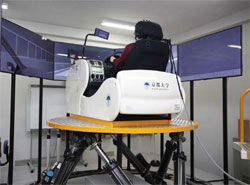 |
 |
| Studying relationship among brain activities, the driver's driving behavior, the road structure, and traffic conditions by measuring brain activities according to driving behavior with near-infrared spectroscopy (NIRS) |
|
| Actions of the Laboratories After Adopting DS |
With the request from the two laboratories and others over several years being accepted, FORUM8's DS for high-level study was installed in the driving simulation laboratory in the C cluster C1 building in the end of March, 2012.
The DS is integrated with UC-win/Road and equipped with a 6-shaft motion controlling function. It has cluster of 8 displays, including 5 displays in front that ensure 180-degree angle of field, both side mirrors and a room mirror, to enable simulation of the driver's behavior in merging such as checking both sides. Moreover, in linking with NIRS, it was made possible to overcome the problem due to the difference in manufacturers of the systems and to make analysis by synchronizing the data obtained from both systems.
Prof. Eiichi Taniguchi studies relationship among brain activities, the driver's driving behavior, the road structure, and traffic conditions. Their studies include a quantitative research on how much load is applied to which part of the driver's brain when driving through a merging section etc.
"However, this approach to studying something by measuring brain activities has just started." He thinks it will be necessary to make calibration of the result measured with NIRS and also to compare the result with that of other approach.
On the other hand, Associate Professor Nobuhiro Uno and others are making a joint study with Hanshin Expressway in order to verify the effect of safe-driving-support information at the merging section of the urban expressway as part of studies on safety support at the merging section. Different kinds of Information were provided to analyze their impact on the speed or access operation of the vehicle just coming into the merging section. Students are improving the DS by applying CCD camera, partly because they want to measure the action of taking one's foot off the accelerator pedal and move to the brake (preparation action).
He focuses in particular on the function of the DS to enable the users not only to set the number of vehicles etc. but also to design a road. Its advantages were shown in that they had the test subjects of the experiment of this time become familiar with the DS operation using the course previously created by the student, and that they had a large number of subjects cooperate with them, who were well-balanced in terms of age groups and driving experiences.
However, assistant Professor Toshiyuki Nakamura finds it a problem to solve in the future that the interfacing of the eye-tracking function with the DS needs to be adjusted after its operation.
| Further Expansion and Expectation Towards the Future |
According to Prof. Eiichi Taniguchi, they would like to challenge diverse possibilities by utilizing features of the DS such as for developing a method to quantitatively judge the driving ability of elderly people with varied conditions of roads and traffic. What's more, he shows the direction of the future studies saying that they would like to reflect the drive assist system in the DS to see how driving easiness and mental load change. He expects the role of the community where they can exchange expertise of the DS across areas of specialization.
Assistant Professor Toshiyuki Nakamura is
interested in linking the above-mentioned tsunami evacuation model with DS, as
well as evaluating the usability of big data using DS. He is also willing to
collaborate with FORUM8, for example, in technology development for
incorporating the vehicle behavior model that he and others studied and created
into the DS.
Associate Professor Nobuhiro Uno discusses the future use of DS, mentioning
evaluation of relationship between the road design and safe driving or
driving actions themselves, an attempt for the driver to see his or her
own driving objectively through the simulator, or studies for meeting the
demands of the elderly who want to drive. In fact, not a few things about
transport are still unclear, and it is essential to use advanced ICT including
DS to solve them. However, he warns that even when having data, one may
be drown in it without a clear course of action.
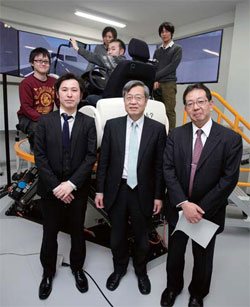 |
| Members of the Logistics Management Systems Laboratory and Intelligent Transport Systems Laboratory in the Department of Urban Management, Graduate School of Engineering, Kyoto University |
(Interviewed and written by Takashi Ikeno)
